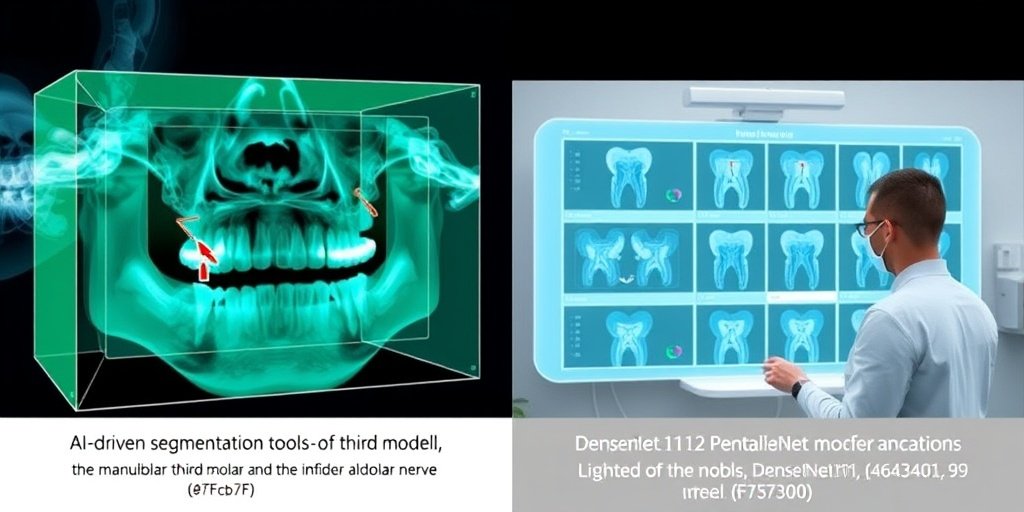⚡ Quick Summary
This study explored the use of UNet and transfer learning models to automate the assessment of the relationship between the mandibular third molar (MM3) and the inferior alveolar nerve (IAN) using panoramic radiographs. The UNet model achieved an impressive accuracy of 0.97 in image annotation, while the best transfer learning model, DenseNet121, reached an average accuracy of 0.84.
🔍 Key Details
- 📊 Dataset: 714 panoramic radiographs from over 500 patients
- 🧩 Classes: Four classifications of MM3 and IAN relations
- ⚙️ Technology: UNet for annotation, DenseNet121 for classification
- 🏆 Performance: UNet: Accuracy 0.97; DenseNet121: Accuracy 0.84, Precision 0.86, Recall 0.84, F1-score 0.85
🔑 Key Takeaways
- 📊 Automated assessment of MM3 and IAN relations can significantly enhance surgical planning.
- 💡 UNet model demonstrated exceptional performance in annotating images.
- 👩🔬 Transfer learning models like DenseNet121 showed strong classification capabilities.
- 🏆 DenseNet121 achieved an average accuracy of 0.84 across all folds and classes.
- 🌍 Study conducted at Jordan University Hospital, highlighting local research initiatives.
- 🔄 Future research directions could explore further applications of this technology in dentistry.
- 📈 High performance compared to existing techniques indicates a promising future for AI in oral surgery.

📚 Background
The relationship between the mandibular third molar and the inferior alveolar nerve is crucial in oral and maxillofacial surgery due to the potential risk of nerve injury. Traditional assessment methods can be subjective and time-consuming, making the automation of this process a significant advancement in the field. The integration of machine learning technologies, particularly UNet and transfer learning, offers a new avenue for improving diagnostic accuracy and efficiency.
🗒️ Study
This study utilized a dataset of 714 panoramic radiographs from more than 500 patients to evaluate the performance of various transfer learning models in classifying the relationships between MM3 and IAN. The researchers employed the UNet model for image annotation, which was then augmented to create a balanced dataset of 1021 images for classification purposes.
📈 Results
The UNet model achieved an outstanding accuracy of 0.97 in annotating the images. Among the transfer learning models, DenseNet121 emerged as the best performer, achieving an average accuracy of 0.84, with a precision of 0.86, recall of 0.84, and an F1-score of 0.85. These results indicate a high level of reliability in classifying the relationships between MM3 and IAN.
🌍 Impact and Implications
The findings of this study have significant implications for the field of oral and maxillofacial surgery. By automating the assessment of MM3 and IAN relations, dentists can enhance their diagnostic capabilities, leading to improved surgical outcomes and reduced risk of nerve injuries. This approach not only streamlines the workflow but also opens up new research avenues in the application of AI technologies in dentistry.
🔮 Conclusion
This study highlights the remarkable potential of machine learning in automating the assessment of critical anatomical relationships in dentistry. The high performance of the UNet model and the transfer learning models suggests that these technologies can significantly improve the accuracy and efficiency of surgical planning. As research in this area continues to evolve, we anticipate even more innovative applications of AI in healthcare.
💬 Your comments
What are your thoughts on the use of AI in dental assessments? We would love to hear your insights! 💬 Leave your comments below or connect with us on social media:
Automated assessment and detection of third molar and inferior alveolar nerve relations using UNet and transfer learning models.
Abstract
Panoramic radiographs (PRs) are widely used in assessing the relationship between the mandibular third molar (MM3) and the inferior alveolar nerve (IAN). The relationship of MM3 and IAN is a critical consideration in oral and maxillofacial surgery due to the risk of nerve injury that can lead to anesthesia in the lower lip or chin. This study aimed to evaluate the performance of different transfer learning models in classifying these relations into four classes after detecting and segmenting the MM3 and the IAN using a new method with the UNet model. 714 PRs from more than 500 patients, representing four classes, were utilized in a UNet model to annotate the MM3 and IAN. Then, the annotations were extracted and augmented to yield 1021 images, thereby achieving a more balanced distribution of samples in each class. Different transfer learning models were evaluated in classifying the images using 10-fold cross-validation. The UNet model achieves an accuracy of 0.97 in annotating the images. The transfer learning models performed well. The best model, DenseNet121, achieved an average accuracy of 0.84, precision of 0.86, recall of 0.84, and F1-score of 0.85 across all folds and classes. The proposed approach demonstrates high performance compared to other works, classifying four classes and achieving similar or better performance than other techniques. It can also benefit dentists at the annotation and classification stages. Based on our results, this approach holds promise for opening several research directions in the future.Trial registration: This study was approved by the internal review boards (IRB) of the Jordan University Hospital (JUH) (Ref. No. 10/2025/3202).
Author: [‘Klaib AF’, ‘Saif A’, ‘Alhosanie TN’, ‘Barakat M’, ‘AbuHijleh I’, ‘Khasawneh R’, ‘AlMadani W’, ‘Alomari S’, ‘Alghanim D’, ‘Dabobash B’, ‘Hussien T’, ‘Shalbak J’, ‘Darweesh M’, ‘AlHadidi A’, ‘Abu Karaky A’]
Journal: Sci Rep
Citation: Klaib AF, et al. Automated assessment and detection of third molar and inferior alveolar nerve relations using UNet and transfer learning models. Automated assessment and detection of third molar and inferior alveolar nerve relations using UNet and transfer learning models. 2025; 15:34529. doi: 10.1038/s41598-025-17753-0